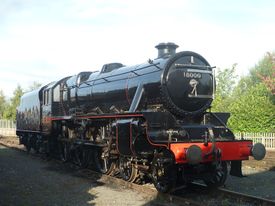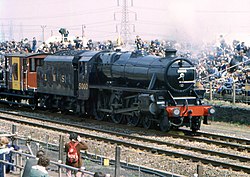LMS Stanier Class 5 45000
| LMS Stanier Class 5 45000 | |
|---|---|
 LMS 5000 at the NRM, York (2011) | |
| Built By | LMS, Crewe |
| Configuration | 4-6-0 |
| BR rating | 5MT |
| Status | National Collection exhibit |
| Loco Number | 45000 |
| Other Numbers | LMS 5000 |
| History | |
| Built | 1935 |
| Designed By | William Stanier |
| Type | 5MT Black Five |
| 1967 | Selected for the National Collection following withdrawal |
| 1977 | Arrived on the SVR for restoration |
| 1979 | Entered service |
| 1989 | Withdrawn from service |
| 1991 | Returned to the NRM |
| Technical | |
| Length | 63ft 7¾" |
| Weight | 72t 4cwt |
| Tractive effort | 25,455 lb |
| Pressure | 225 lb/sq in |
Contents
Service
LMS No 5000 was the first ‘Black 5’ built by Crewe, although it was preceded into service by No 5020 built by the Vulcan Foundry who also built the SVR’s 45110. 5000 entered service in March 1935, being renumbered as 45000 by BR in 1949. Its working life was mostly based around Crewe, until being withdrawn from service by BR at Lostock Hall in October 1967.
Preservation
Black 5s, like most locomotives, were frequently modified during their working life. On withdrawal, 45000 was chosen to be included in the National Collection as the only surviving example with its original short firebox and domeless boiler.
Restoration
45000 arrived at the SVR on loan from the National Railway Museum on 19 November 1977, with the intention of being restored for main line working. Stripping the locomotive began straight away, the first task being to empty several barrow loads of ash from the smokebox left over from the last steaming 10 years earlier. However pressure of work on other SVR locomotives then delayed serious progress until late 1978, with the boiler being lifted by the 30 ton steam crane in Christmas week. The boiler work required complete replacement of all 21 big and 136 small tubes plus renewal of a number of firebox stays. This was completed in time for the boiler to be reinstalled on Easter Saturday, 14 April 1979. A rail tour planned for June of that year led to much ‘burning of the midnight oil’, an example of which being that 5000 moved under her own power for the first time at 1.00am on Saturday 28 April.
The restoration was duly completed and the locomotive entered service in LMS livery as No 5000, moving light engine to Hereford on 1 June 1979 in time to work a rail tour the following day[1]. The SVR later won the 1979 ARPS award for restoring 5 locomotives in the year including LMS 5000.[2]
SVR service
45000 took part in the grand parade at the Rocket 150 celebrations at Rainhill in May 1980. Other main line working was carried out from Steam Centres around the country, including the Bulmers Railway Centre at Hereford. Between 1979 and 1988 the locomotive accumulated 34,774 miles on the SVR and in the course of some 20+ rail tours on the main line. Mileage by year was as follows:| Year | Mileage |
|---|---|
| 1979 | 1,650 |
| 1980 | 3,130 |
| 1981 | 2,857 |
| 1982 | 2,936 |
| 1983 | 4,551 |
| 1984 | 5,584 |
| 1985 | 277 |
| 1986 | 2,692 |
| 1987 | 6,462 |
| 1988 | 4,635 |
| Total | 34,774 |
A potentially incomplete listing of main line tours is as follows:
| Date | Tour name | Route | Notes | Web | SVR News |
|---|---|---|---|---|---|
| 2 June 1979 | The Midlander | Hereford-Shrewsbury-Hereford-Newport-Hereford | SBJ] | ||
| 22 Sep 1979 | The Inter-City | Hereford - Chester - Hereford | D/H with 4930 Hagley Hall | SBJ | |
| 19 Apr 1980 | The Black Countryman | Hereford - Shrewsbury - Chester - Manchester Victoria | D/H with 80079 | SBJ | |
| 22 June 1980 | Steam 150 | Manchester Victoria – Liverpool Edge Hill + return | 56-12, 57-9 | ||
| 11 Oct 1980 | The Welsh Dragon | Shrewsbury - Hereford - Newport - Hereford | D/H with 43106 | SBJ | |
| 07 Feb 1981 | Welsh Marches Express | Hereford - Newport - Hereford | SBJ | ||
| 07 Mar 1981 | Welsh Marches Express | Hereford - Newport - Hereford | SBJ | ||
| 01 Aug 1981 | ? | Failed at Shrewsbury with hot box | 61-8 | ||
| 30 Jan 1982 | Welsh Marches Pullman | Shrewsbury - Hereford | SBJ | ||
| 13 Mar 1982 | Welsh Marches Pullman | Hereford - Newport - Hereford(?) | SBJ | ||
| 20 Mar 1982 | Welsh Marches Express | Hereford - Newport - Hereford | D/H with 4930 Hagley Hall | SBJ | |
| 23 Oct 1982 | Welsh Marches Pullman | Hereford(?) - Shrewsbury - Ludlow - Chester | SBJ | ||
| 06 Nov 1982 | Welsh Marches Pullman | Chester - Shrewsbury | SBJ | ||
| 05 Mar 1983 | Welsh Marches Pullman | Hereford(?) - Chester | SBJ | ||
| 05 Mar 1983 | The Deeside Venturer (?) | Chester - Hull(?) | SBJ | ||
| 04 Apr 1983 | The Yorkshire Pullman | ? - Scarborough - ? | SBJ | ||
| 14 May 1983 | Humber Venturer | Hull - Leeds - Chester | SBJ | ||
| 14 May 1983 | Welsh Marches Pullman | Chester - Shrewsbury | SBJ | ||
| 11 June 1983 | 45000 hauled a main line ten coach train of Brunel Society passengers. The route included the goods-only branch from Wapping Dock to Ashton Junction. | 69 |
During her time at the SVR, LMS 5000 was sometimes described as Chief Engineer Alun Rees's "personal locomotive",[3] with sister locomotive 45110 becoming "the Company Black 5". In summer 1982 the locomotive was briefly withdrawn from service while a 2ft 6in crack in the steel firebox door plate was repaired.
The locomotive failed a steam test at the start of the 1989 season,[4] and was returned to the NRM in the spring of 1991.[5] It can normally be seen on display at Locomotion (the NRM museum at Shildon) or the NRM at York.[6]
See also
References
Links
| ||||||||||||||||||||||||||||||||||
